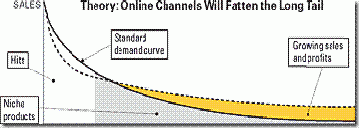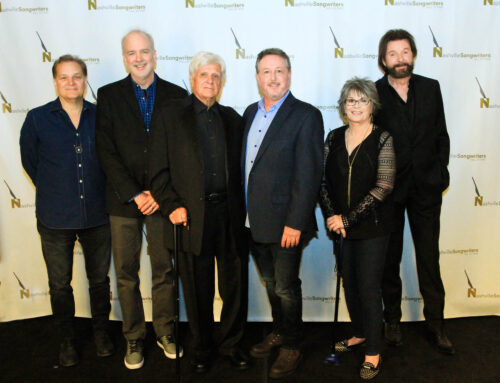A major debate is being spawned by a recent article entitled “Should You Invest in the Long Tail,” written by Anita Elberse, an Associate Professor of Business Administration at Harvard Business School. The debate concerns the accuracy of Chris Anderson’s long tail theory, set out in great detail in his 2006 book, The Long Tail: Why the Future of Business is Selling Less of More.
A summary of the debate is given in this analysis by Glenn Peoples of Coolfer.com. Mr. Anderson’s initial response to Elberse’s criticism’s can be found here and then her subsequent response here.
The long tail theory is an idea that contrasts with the “blockbuster strategy” of marketing, which Elberse accurately describes as “age-old,” i.e. that the limited retail shelf space for media and entertainment product dictates that retailers should maximize their profits by focusing their marketing efforts on the relatively small number of “best sellers.” This is, of course, best exemplified in today’s economy by the Wal-Mart approach. It is, of course, the marketing philosophy that has been used by the major entertainment conglomerates for their entire history of existence. The “blockbuster” product is at the peak of a bell curve, where the demand exists, the trailing end of which has long been described by the economic phrase “long-tail.” See Elberse’s illustration below:
The basic idea behind Anderson’s long tail theory is that the Internet has changed the way consumers look for media and entertainment product. Now that a music consumer can find and afford products more closely tailored to their individual “niche” tastes, i.e., further down the long tail, they will migrate away from the homogenized “blockbuster” hits. Anderson argues that the future of online retail demands a focus that shifts away from blockbusters centers on the long tail—niche offerings that cannot profitably be provided through brick-and-mortar channels. (See Elberse’s sidebar “The Long-Tail Theory in Short.”). Elberse seeks to refute the idea that the long tail is being “fattened” by the online availability of more obscure and less marketed products.
If you are in the music industry, it is well worth following this debate. While I will not attempt an in-depth analysis of Elberse’s criticisms here – I’ll leave that to the capable Mr. Anderson — I do desire to point out what I believe is a very obvious weakness in Elberse’s comments:
To support her conclusion that the long tail is “long but extremely flat—and, as online retailers expand their assortments, increasingly so,” Elberse states that she relies on Nielson SoundScan data. She concludes:
The Nielsen data cover multiple retailers, multiple channels, and multiple years, offering a wealth of material to test aspects of Anderson’s long-tail theory. What emerges is not a rosy picture of the fate of long-tail products: the tail increasingly consists of titles that rarely sell and that are produced by smaller-scale players.
See The Long Tail Debate: A Response to Chris Anderson.
These assumptions about the SoundScan are flawed, I believe. While Elberse is correct in her assessment that the “data cover multiple retailers, multiple channels and multiple years,” I believe it overlooks the fact that SoundScan data is ONLY collected via POS, i.e. “point of sale” collection points. This means cash registers and/or UPC bar code scanners. The UPC code is the series of black and white lines appearing over a numeric code, which appears on virtually everything on the market today.
That is how the “Scan” portion of the name “SoundScan” is derived. When a UPC code on a product is scanned for sale, that UPC data is collected and a stored in a text file, which is delivered to Nielson on a weekly basis. Nielson then collates and formats the data into what we know as the Billboard charts. While the data may include some online retailers, its predominant focus is still on the physical product that sits on the shelves in retail outlets and warehouse all across America. In other words, SoundScan’s predominant purpose – the reason it was created – is to track physical sales which, it turns out, is only the product that falls into the “head” of the long tail. SoundScan’s focus is indubitably not on digital downloads, even though it has obviously made attempts to incorporate the trend in its charting scheme.
Naturally, if a person focuses primarily on the product that exists in the head of the tail, the conclusions reached by that person about what exists in the long tail are going to be slightly skewed.
Elberse might counter this assertion by claiming that she also relied on the Rhapsody data to determine what obscure music was selling in the long tail. Her use of this data is understandable, since Mr. Anderson also relied heavily on the Rhapsody data in drawing many of his conclusions in The Long Tail. I think this reliance on Rhapsody data falsely assumes that what Rhapsody is selling is indicative of what is selling across the entire spectrum of the Internet. Last time I checked, however, Rhapsody had about a 3-4% share of the entire music download market!
This, I believe, is a fatal foundation for many analyses of the digital music revolution and, consequently, of the validity of the long tail. I’m not aware of any comprehensive analysis that includes data from not only the mega online powerhouse, such as iTunes of course, which has about a 70% share of the digital download market, but also retailers of independent, less market-driven music, such as eMusic — which, by the way, has a respectable 10% of the market share of digital downloads. It is the success of the later that, in my humble opinion, deserves more consideration in any analysis of the viability of the long tail approach to today’s digital market. I can only speak for myself – I buy more music from eMusic than I do from iTunes, Zune, Amazon and Rhapsody combined. So, to all of you researchers out there, please incorporate some serious data from the long tail! Until that type of analysis is done, the conclusions drawn by Elberse must be viewed as somewhat suspect or, at the very least,
only applicable to the specific subset of data she analyzed, i.e., not extrapolated to the entire music download market as a whole, but limited to SoundScan and Rhapsody.






